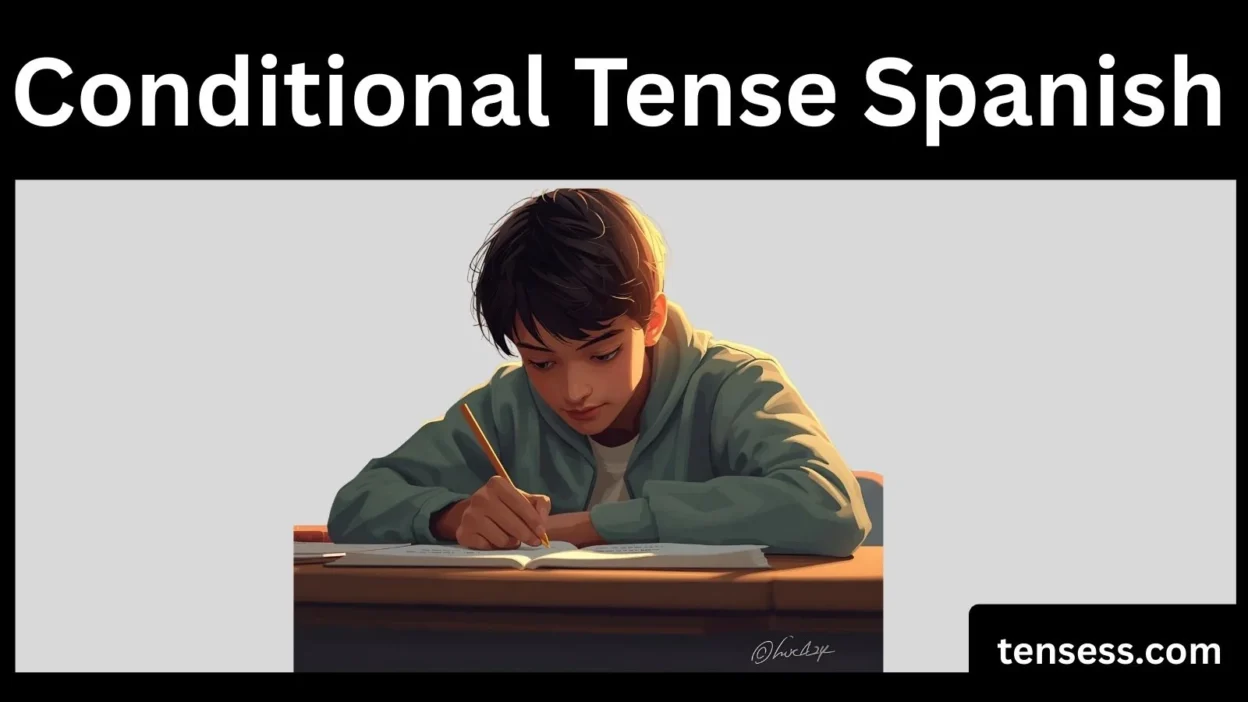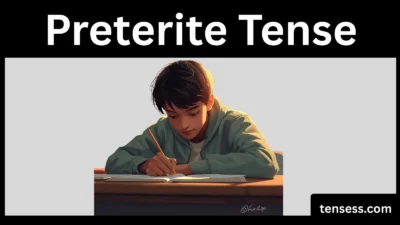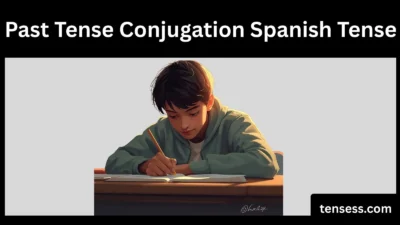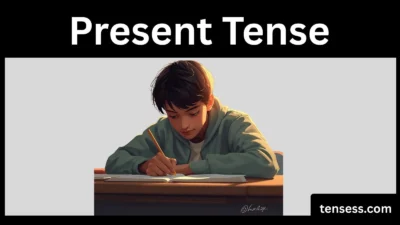The Spanish conditional tense is a vital tool for language learners, students, writers, and grammar enthusiasts looking to express hypothetical situations, polite requests, or future possibilities relative to the past.
if you’re saying “I would go” or “She could stay,” this tense adds nuance to your Spanish conversations.
In this beginner-friendly guide, we’ll break down the conditional tense in Spanish, explaining its structure, conjugation, and usage with real-life verb tense examples.
By the end, you’ll feel confident using the conditional tense in everyday scenarios.
Let’s dive into what makes this tense unique, how to form it, and how to avoid common pitfalls, all while keeping things clear and engaging.
Ready to master the Spanish conditional tense? Let’s get started!
What Is the Conditional Tense in Spanish?
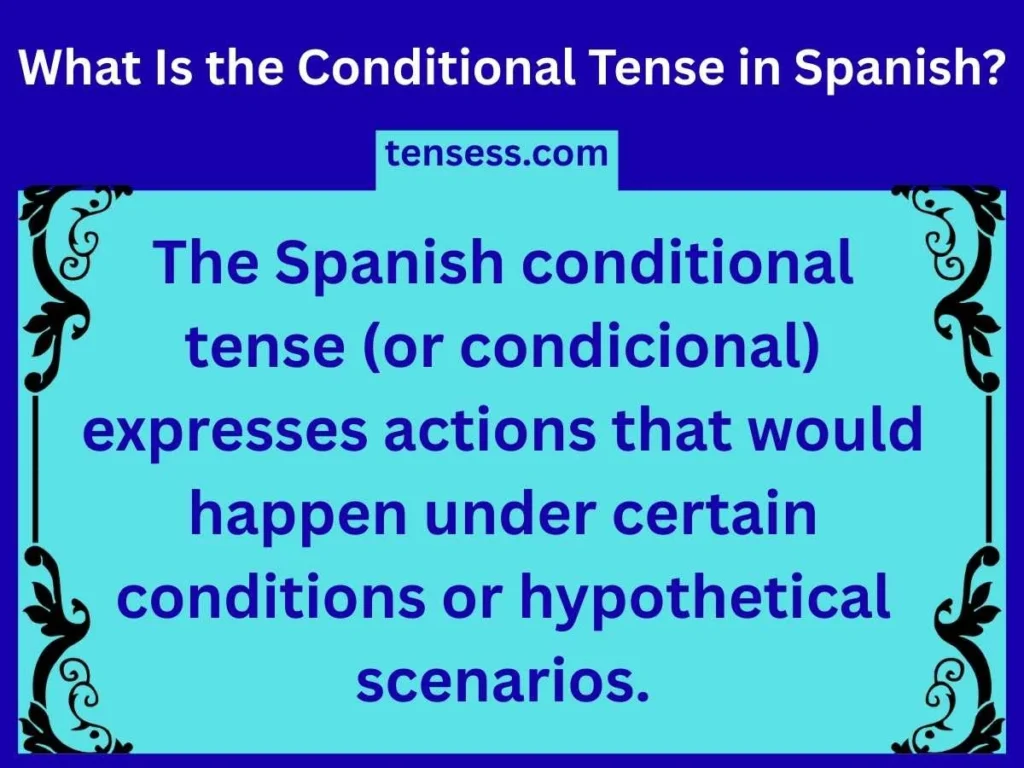
It’s often used for politeness (“Would you like…?”), possibilities (“I would travel…”), or speculation about the past (“They would have arrived…”). In English, it’s equivalent to “would + verb.” This tense is commonly used with verbs like hablar (to speak), comer (to eat), or vivir (to live). Recognizing it in sentences is key for understanding nuanced communication in Spanish.
Recognition of Conditional Tense Spanish
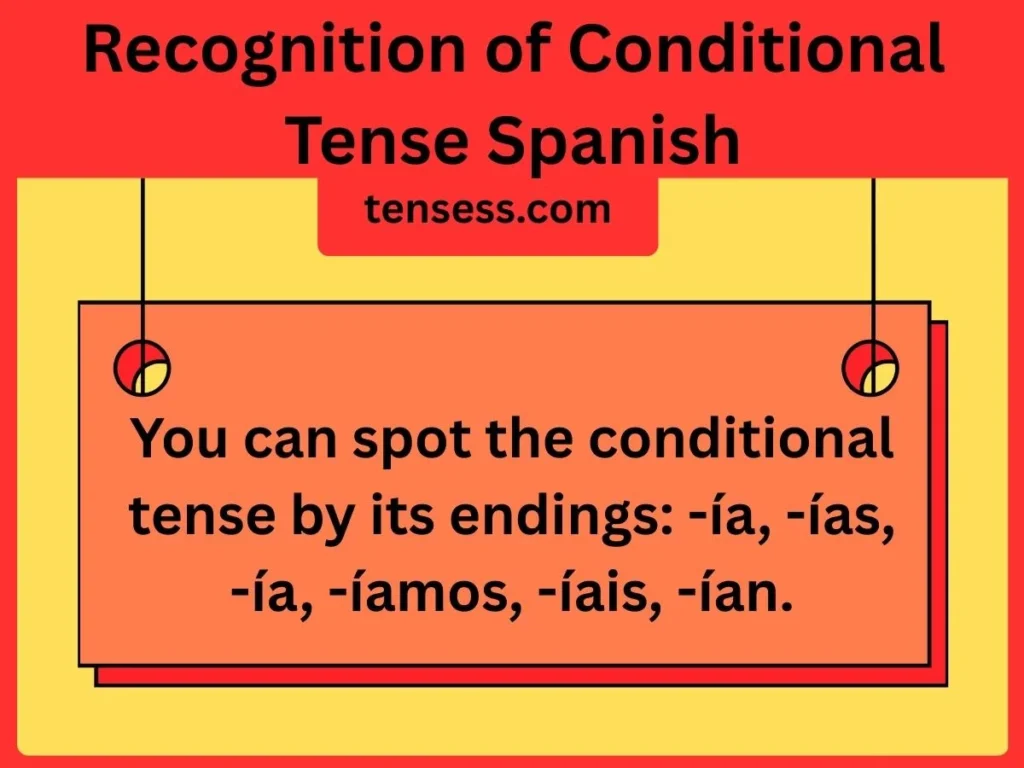
For example, in hablaría (“I would speak”), the -ía signals the conditional. It often appears with words like si (if) in hypothetical clauses or polite phrases.
Structure of Sentence on Conditional Tense Spanish
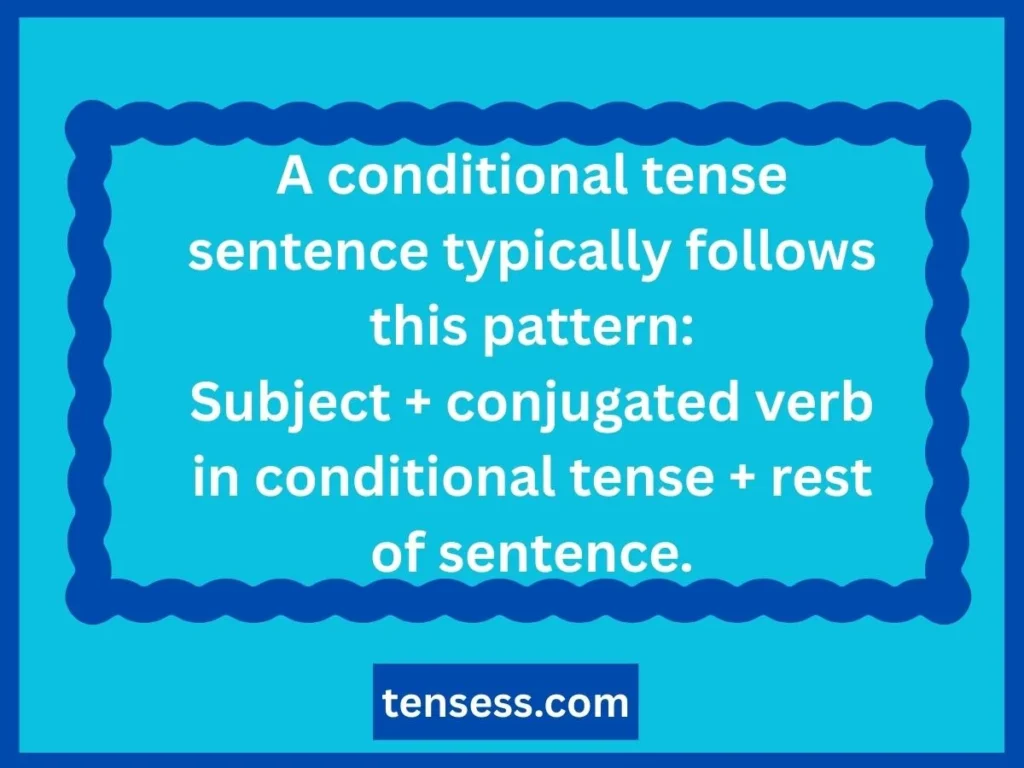
Example: Yo comería pizza (I would eat pizza).
It can also pair with the imperfect subjunctive in si clauses, like: Si tuviera tiempo, viajaría (If I had time, I would travel).
Formation of Conditional Tense Spanish
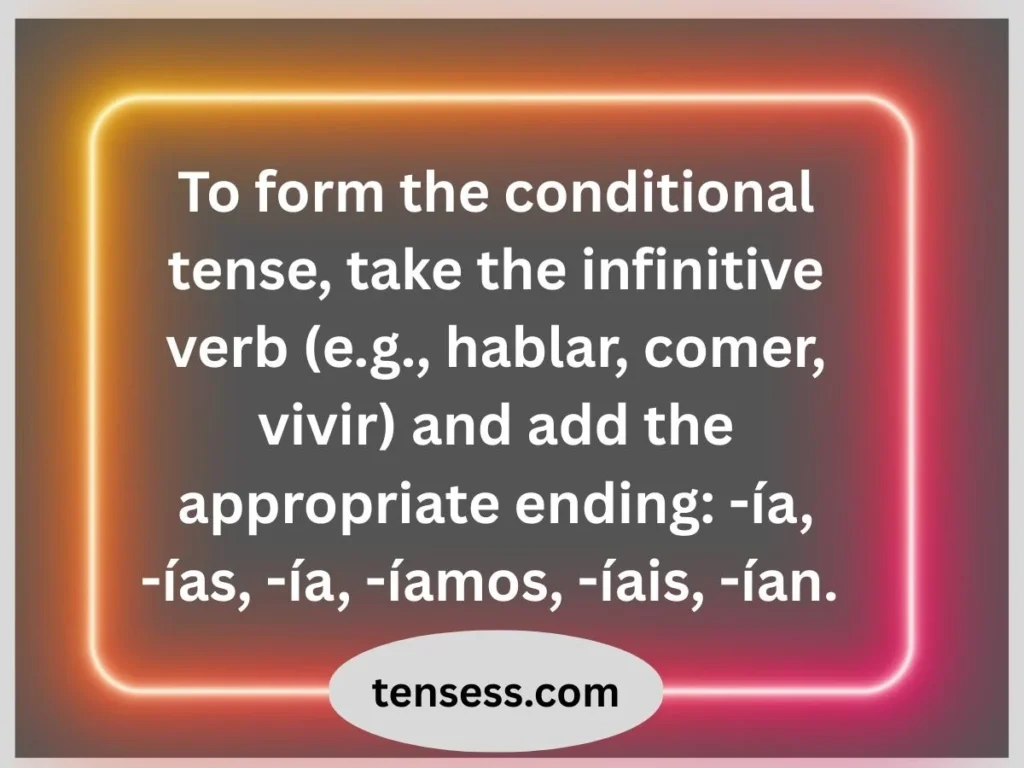
For irregular verbs, use the irregular stem (e.g., tener → tendr-) before adding endings.
Verbs
The conditional tense applies to all Spanish verbs, including regular verbs (e.g., cantar, aprender) and irregular verbs (e.g., decir, hacer). Most verbs follow a predictable pattern, but some have unique stems.
Helping Verbs
No auxiliary or helping verbs are needed for the conditional tense in Spanish, unlike English’s “would.” The tense is formed directly on the verb itself.
Define the Verb in the Conditional Tense
The conditional tense conveys hypothetical or conditional actions, such as desires, possibilities, or polite requests. For example, comer (to eat) becomes comería (I would eat), indicating a hypothetical action.
Regular or Irregular
Most verbs are regular in the conditional tense, following the infinitive + ending rule. However, some common verbs are irregular, using unique stems (e.g., haber → habr-, poder → podr-).
10 Simple Sentence Examples
- Yo hablaría con ella mañana. (I would speak with her tomorrow.)
- Tú comerías más si tuvieras hambre. (You would eat more if you were hungry.)
- Él viajaría a España. (He would travel to Spain.)
- Nosotros aprenderíamos rápido. (We would learn quickly.)
- Vosotros cantaríais en el coro. (You all would sing in the choir.)
- Ellas escribirían una carta. (They would write a letter.)
- Yo viviría en la playa. (I would live on the beach.)
- Tú bailarías toda la noche. (You would dance all night.)
- Ella estudiaría más. (She would study more.)
- Ellos jugarían al fútbol. (They would play soccer.)
How to Conjugate the Conditional Tense
Conjugating the Spanish conditional tense is straightforward for regular verbs. Follow these steps:
- Take the infinitive verb (e.g., hablar, comer, vivir).
- Keep the full infinitive as the stem.
- Add the endings: -ía, -ías, -ía, -íamos, -íais, -ían.
- For irregular verbs, use the irregular stem (e.g., decir → dir-).
- Ensure subject-verb agreement.
- Double-check for spelling changes in irregular verbs.
- Use the same endings for -ar, -er, and -ir verbs.
- Practice with common verbs like ser or estar.
- Memorize the 12 irregular stems (e.g., haber, poder, querer).
- Test your conjugations in full sentences.
Conjugation Table
Here’s a conjugation table for the regular verb hablar (to speak) and the irregular verb decir (to say):
| Subject | Hablar (Regular) | Decir (Irregular) |
| Yo | hablaría | diría |
| Tú | hablarías | dirías |
| Él/Ella/Ud. | hablaría | diría |
| Nosotros | hablaríamos | diríamos |
| Vosotros | hablaríais | diríais |
| Ellos/Uds. | hablarían | dirían |
Spelling Changes or Irregularities
Regular verbs like hablar, comer, and vivir follow the standard pattern. Irregular verbs have unique stems but use the same endings. Common irregular stems include:
- haber → habr- (e.g., habría)
- poder → podr- (e.g., podría)
- querer → querr- (e.g., querría)
- saber → sabr- (e.g., sabría)
- decir → dir- (e.g., diría)
No additional spelling changes occur beyond these stem changes.
Examples of Conditional Tense Sentences
- Yo comería pizza si no estuviera a dieta. (I would eat pizza if I weren’t on a diet.)
- Tú tendrías más tiempo libre. (You would have more free time.)
- Él diría la verdad. (He would tell the truth.)
- Nosotros viajaríamos a México. (We would travel to Mexico.)
- Vosotros cantaríais mejor con práctica. (You all would sing better with practice.)
- Ellas serían muy felices aquí. (They would be very happy here.)
- Yo podría ayudarte mañana. (I could help you tomorrow.)
- Tú vivirías en una casa grande. (You would live in a big house.)
- Ella escribiría un libro. (She would write a book.)
- Ellos aprenderían español rápidamente. (They would learn Spanish quickly.)
- Yo querría un café, por favor. (I would like a coffee, please.)
- Tú estarías cansado después del viaje. (You would be tired after the trip.)
- Él sabría la respuesta. (He would know the answer.)
- Nosotros haríamos una fiesta. (We would throw a party.)
- Ellas saldrían temprano. (They would leave early.)
Common Mistakes with the Conditional Tense
- Confusing with future tense: The conditional uses infinitive + -ía, not -é like the future tense. Example: hablaría (correct) vs. hablaré (wrong).
- Forgetting irregular stems: Using deciría instead of diría for decir. Memorize the 12 irregular stems.
- Incorrect endings: Using -ías for yo (e.g., yo hablarías) instead of -ía.
- Overusing in si clauses: The conditional doesn’t go in the si clause; use imperfect subjunctive (e.g., Si tuviera, not Si tendría).
- Ignoring subject agreement: Ensure the ending matches the subject (e.g., nosotros hablaríamos, not hablarían).
- Misplacing accents: Accents are on the í in all endings (e.g., hablaría, not hablaria).
- Using English “would” structure: Avoid translating directly; Spanish doesn’t use auxiliary verbs.
- Mixing tenses in clauses: Pair the conditional with imperfect subjunctive in si clauses.
- Forgetting context: Use the conditional for hypotheticals, not certainties.
- Not practicing irregulars: Regularly review verbs like poder, haber, and querer.
Related Verbs and Synonyms for the Conditional Tense
The conditional tense applies to all verbs, but some are commonly confused:
- Poder (to be able to) vs. Querer (to want): Podría (I could) implies ability, while querría (I would want) implies desire.
- Ser vs. Estar: Sería (I would be, permanent) vs. estaría (I would be, temporary).
- Decir vs. Hablar: Diría (I would say) focuses on content, while hablaría (I would speak) focuses on the act.
- Hacer vs. Realizar: Haría (I would do/make) is more general than realizaría (I would carry out).
- Tener vs. Poseer: Tendría (I would have) is more common than poseería (I would possess).
Sentence Comparisons
- Podría ir al cine. (I could go to the cinema.) vs. Querría ir al cine. (I would want to go to the cinema.)
- Sería un buen doctor. (I would be a good doctor, permanently.) vs. Estaría cansado. (I would be tired, temporarily.)
- Diría la verdad. (I would say the truth.) vs. Hablaría con ella. (I would speak with her.)
Tips to Practice Using the Conditional Tense
- Write hypothetical scenarios (e.g., “If I won the lottery, I would…”).
- Practice polite requests (e.g., ¿Podrías ayudarme?).
- Use flashcards for irregular stems.
- Pair with imperfect subjunctive in si clauses.
- Read Spanish literature to spot the tense.
- Speak with native speakers to practice context.
- Create daily sentences using different verbs.
- Listen to Spanish podcasts for real-life usage.
- Use apps like Duolingo for conjugation drills.
- Review mistakes in your writing regularly.
Frequently Asked Questions
- What’s the difference between conditional and future tense?
The conditional expresses hypotheticals (“would”), while the future expresses certainties (“will”). - When is the conditional tense used?
For hypotheticals, polite requests, or future-in-the-past scenarios. - Are there irregular verbs in the conditional tense?
Yes, 12 verbs have irregular stems (e.g., decir → dir-). - Can I use the conditional in si clauses?
No, use the imperfect subjunctive in the si clause. - How do I memorize irregular stems?
Use mnemonic devices or flashcards. - Is the conditional used for politeness?
Yes, like ¿Podrías ayudarme? (Could you help me?). - Do all verbs use the same endings?
Yes, -ía, -ías, -ía, -íamos, -íais, -ían. - What’s a common mistake to avoid?
Confusing irregular stems like tendría with tenería. - Can I use the conditional with any verb?
Yes, regular and irregular verbs work. - How do I practice effectively?
Write sentences, read, and speak regularly.
Exercises
- Conjugate vivir in the conditional for all subjects.
- Write 5 sentences using poder in the conditional.
- Create a si clause sentence with tener and viajar.
- Identify the conditional tense in a short Spanish paragraph.
- Translate: “I would eat” into Spanish.
- Correct: Yo hablaría vs. Yo hablaré.
- Use hacer in a polite request sentence.
- Combine ser and estar in conditional sentences.
- Write a hypothetical scenario using querer.
- Practice decir with 3 different subjects.
Quizzes
- What’s the conditional of comer for tú?
a) comerás b) comerías c) comería
Answer: b) comerías - Which verb has an irregular stem?
a) hablar b) poder c) vivir
Answer: b) poder - True/False: The conditional is used in si clauses.
Answer: False - What’s the stem for haber?
a) hab- b) habr- c) haber-
Answer: b) habr- - Translate: Ella diría.
a) She would say b) She will say c) She says
Answer: a) She would say - What’s the ending for nosotros?
a) -ía b) -íamos c) -ían
Answer: b) -íamos - Correct the mistake: Yo tendrí.
Answer: Yo tendría - Which is correct?
a) Si tendría b) Si tuviera c) Si tendré
Answer: b) Si tuviera - Conjugate saber for ellos.
Answer: sabrían - Write a sentence with querría.
Example Answer: Querría un té, por favor.
Conclusion
Mastering the Spanish conditional tense opens up new ways to express hypotheticals, politeness, and possibilities in Spanish.
By understanding its formation, recognizing irregular verbs, and practicing with real-life verb tense examples, you can confidently use this tense in conversations or writing.
Avoid common mistakes like confusing it with the future tense or misusing irregular stems, and practice regularly with exercises and quizzes to solidify your skills.
Whether you’re a student, language learner, or grammar enthusiast, the conditional tense is a powerful tool to enhance your Spanish fluency.
Try writing your own sentences or use a grammar checker to refine your work.
Share your practice sentences in the comments or explore more Spanish grammar tips on our blog to keep learning!
